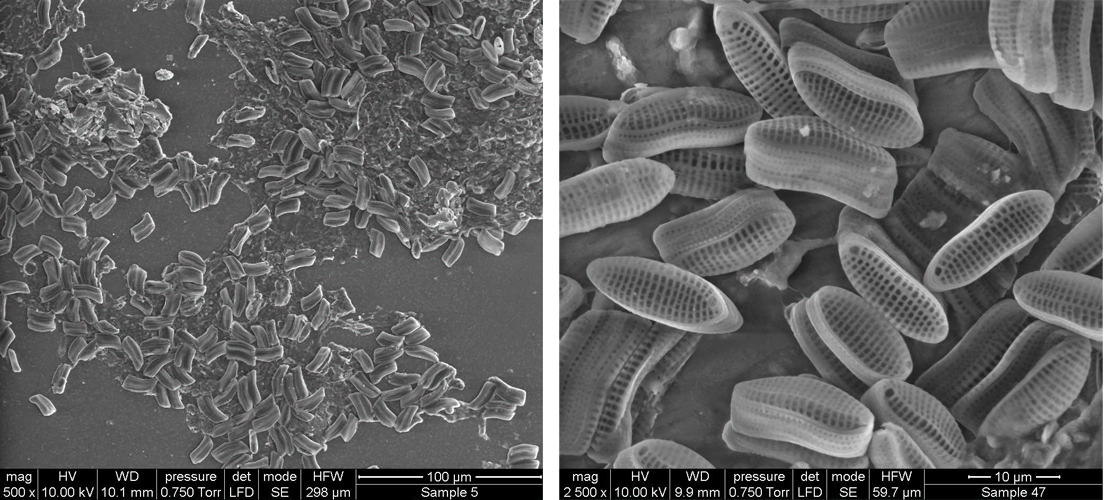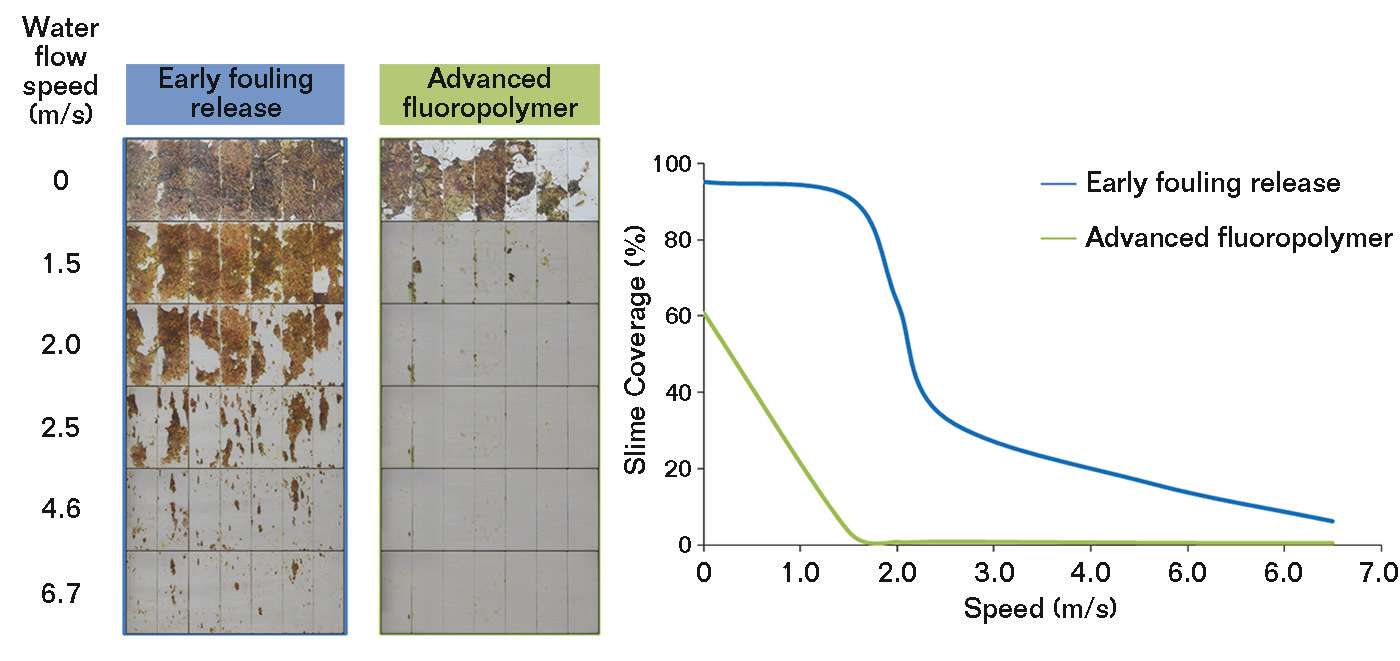The settlement and build-up of organisms on wet structures in marine environments is known as biofouling. Barnacles and other marine organisms that adhere to ship hulls and marine structures are commonly known forms of biofouling. Power plants and water treatment facilities that use water from rivers and the sea can be impacted by biofouling as well. Biofouling organisms can be categorized into two groups: macrofouling, which covers plants and animals such as barnacles, mollusks, tubeworms, and green weed; and microfouling, which is comprised of unicellular algae and bacteria also known as slime. In addition to causing hydrodynamic drag for ships and industrial processes that rely on optimum water flow, biofouling also reduces the accessibility of steel and concrete surfaces for corrosion inspections, which affects marine structures such as ships; floating production, storage, and offloading (FPSO) vessels; offshore wind tower foundations; and offshore oil and gas structures. Biofouling is known to cause various industrial problems, such as corrosion, increased drag force, and reduced heat transfer efficiency. Once biofouling has occurred, removing it can be very difficult, and risks include damaging the underlying protective coating.
 A biocide-free, advanced fluoropolymer fouling-release coating technology has been developed by AkzoNobel Marine & Protective Coatings to deter the formation of both macro- and microfouling on marine structures and industrial processes. According to Ian Fletcher, senior market manager with AkzoNobel Marine & Protective Coatings’ International Paint, easy removal of biofouling is important for corrosion control. On static structures, such as the steel legs of an offshore oil platform or the hull of an FPSO, the structural integrity of the welds need to be visually inspected and assessed. If the substrate is covered in biofouling that isn’t easily removed, a large amount of force is required to scrape it off, which may damage the underlying protective coating and leave the substrate vulnerable to corrosion.
A biocide-free, advanced fluoropolymer fouling-release coating technology has been developed by AkzoNobel Marine & Protective Coatings to deter the formation of both macro- and microfouling on marine structures and industrial processes. According to Ian Fletcher, senior market manager with AkzoNobel Marine & Protective Coatings’ International Paint, easy removal of biofouling is important for corrosion control. On static structures, such as the steel legs of an offshore oil platform or the hull of an FPSO, the structural integrity of the welds need to be visually inspected and assessed. If the substrate is covered in biofouling that isn’t easily removed, a large amount of force is required to scrape it off, which may damage the underlying protective coating and leave the substrate vulnerable to corrosion.
 Biofouling traditionally has been controlled with antifouling coatings. These include coatings that release active biocides into the water to deter the settlement of organisms; and biocide-free, “self-cleaning” fouling-release coatings that influence the adhesion strength of fouling organisms so they fall off the coating or are swept off the coating by water flow. Lyndsey Tyson, team leader—fouling control with the AkzoNobel Marine & Protective Coatings’ Technology Centre, and Fletcher explain that silicone-based coatings were the first commercially available biocide-free fouling-release coatings. They feature a smooth, hydrophobic (water repellant) surface and are very effective for controlling macrofouling; however, they are less successful in preventing microfouling build-up and are susceptible to moderately heavy microfouling, which is particularly detrimental for industrial processes.
Biofouling traditionally has been controlled with antifouling coatings. These include coatings that release active biocides into the water to deter the settlement of organisms; and biocide-free, “self-cleaning” fouling-release coatings that influence the adhesion strength of fouling organisms so they fall off the coating or are swept off the coating by water flow. Lyndsey Tyson, team leader—fouling control with the AkzoNobel Marine & Protective Coatings’ Technology Centre, and Fletcher explain that silicone-based coatings were the first commercially available biocide-free fouling-release coatings. They feature a smooth, hydrophobic (water repellant) surface and are very effective for controlling macrofouling; however, they are less successful in preventing microfouling build-up and are susceptible to moderately heavy microfouling, which is particularly detrimental for industrial processes.
“These fouling release technologies have not been 100% fouling free,” Fletcher says. “They have good resistance to growth of weed and barnacle types of fouling, but slime fouling is something that nobody had managed to really deter, and any type of fouling will have an impact on the hydrodynamic efficiency of a surface.”
Silicone hydrogel coatings with surfaces that are highly hydrophilic (show a strong affinity for water) have been evaluated as fouling-release coatings and proved to be successful at inhibiting microfouling over a short time period, comment Tyson and Fletcher. Their high affinity for water however, limits the service life of these coatings because of film dissolution in the surrounding environment.
These issues were addressed by the development of a fluoropolymer fouling-release coating technology that creates an amphiphilic surface, which is a combination of hydrophilic and hydrophobic surfaces. Marine organisms prefer either a hydrophobic or a hydrophilic surface, depending on the organism, so a completely hydrophobic or hydrophilic surface will cause preferential settlement of fouling organisms, Tyson and Fletcher explain. The amphiphilic nature of the fluoropolymer technology creates an inhospitable surface that disrupts settlement and influences the adhesion of a wide range of fouling organisms. The amphiphilic properties also contribute to a longer service lifetime of the fouling-release coating. The fluoropolymer fouling-release coating demonstrated better antifouling performance for macrofouling than traditional antifouling technologies; and while it showed better microfouling inhibition than silicone-based technologies, the researchers at AkzoNobel felt its performance for slime control could still be improved.
The settlement and release of macrofouling is influenced by several coating properties, Tyson and Fletcher comment, noting it is well documented that a coating’s surface chemistry and surface charge, thickness and modulus, roughness, and color all affect its effectiveness. The specific parameters that affect the settlement and adhesion of microfouling on a coating, however, were not as well understood. As a result, an extensive study was undertaken that examined the composition and diversity of biofilms found on marine structures and evaluated the specific coating properties that influence slime adhesion. Knowledge attained from this study was used to design and synthesize a customized, high-performance fluoropolymer that was incorporated into the advanced fluoropolymer fouling-release coating. “The technology we’re talking about here is the first one that can really deter the build-up of slime,” Fletcher adds.
With a better understanding of the characteristics that influence slime adherence, the coating formulators were able to optimize the amphiphilic nature of the advanced fluoropolymer technology—the size and distribution of different surface energy regions were more pronounced, which improved the coating’s slime release properties. “While the surface is amphiphilic, it has more of a hydrophilic characteristic, and that is what deters the slime adhesion,” says Tyson. Although the amphiphilic characteristic is not unique for a coating, Tyson notes that it is the way hydrophobic and hydrophilic properties are balanced in this advanced fluoropolymer coating that is unique. “We have really pushed the boundaries with this technology,” she comments.
While the advanced fluoropolymer coating technology was being developed, researchers with AkzoNobel designed several new laboratory test methods to accurately measure the coating’s slime deterrence and release performance under hydrodynamic water flow in a range of simulated operating conditions. To grow slime on test panels, a multispecies slime culturing reactor was developed. Test panels with the advanced fluoropolymer and a silicone-based fouling-release coating were fouled with slime, then exposed to increasing rates of water flow (from 0.0 to 7.0 m/s) that ran parallel to the surface. A multispeed hydrodynamic flow cell mimicked in-service turbulence, and a combination of high-resolution imaging and digital image analysis determined the quantity of slime removed as a function of water flow speed.
Results indicated that slime on the silicone-based coating typically did not release below a water flow rate of 1.5 m/s and required a flow of >6.7 m/s for complete slime removal. This compared to complete slime removal in a water flow rate of 1.5 m/s for the advanced fluoropolymer coating. Field tests on panels coated with the advanced fluoropolymer fouling-release coating and an epoxy primer were conducted in several marine environments around the world. The coatings were assessed by the percentage of fouling occurring over time. After more than 40 weeks of testing, the percentage of surface fouling on the advanced fluoropolymer coating panel was ~10% compared to ~100% for the epoxy primer.
Additionally, several field tests were carried out to determine the adhesion strength as well as the percentage of macrofouling settlement. In one test off the west coast of Sweden, panels with anticorrosion, advanced fluoropolymer, and silicone-based coatings were statically immersed in seawater, and adult barnacles adhered to them. A handheld force gauge was used to measure the force required to remove a barnacle, and the adhesion strength was calculated using the measured force and the area of the test panel. The adhesion strength was ~100 psi (690 kPa) for the anticorrosion coating; ~9 psi (62 kPa) for the silicon-based fouling-release coating; and ~5 psi (34 kPa) for the advanced fluoropolymer fouling-release coating, which is about the same as wiping by the coating by hand, Fletcher says. In an independent test conducted by Newcastle University, barnacle cyprid larvae were induced to settle on panels coated with the advanced fluoropolymer and the silicon-based fouling-release coatings, and the percentage of coverage by the settled barnacles was measured. Test results showed that the percentage of barnacle coverage was ~14% for the silicone-based coating and ~1.8% for the advance fluoropolymer coating.
To achieve the smooth surface that performs best for fouling release, the advanced fluoropolymer coating is normally applied by an airless sprayer at a thickness of 150 µm over two 150-µm thick coats of an anticorrosion epoxy coating that is topped with a 100-µm thick tie coating, and cured under atmospheric conditions.
More information on the advanced fluoropolymer coating technology and test results can be found in CORROSION 2014 paper no. 4468, “Novel Slime Release Biocide Free Technology,” by L. Tyson and I. Fletcher.
Contact Lyndsey Tyson, AkzoNobel Marine & Protective Coatings—e-mail: Lyndsey.Tyson@akzonobel.com; and Ian Fletcher, International Paint—e-mail: Ian.Fletcher@akzonobel.com.